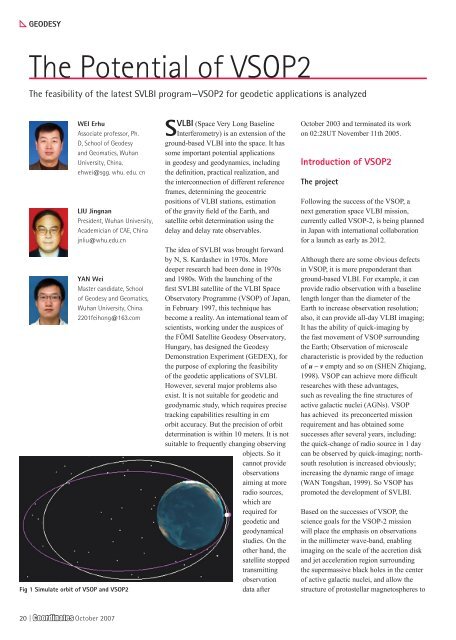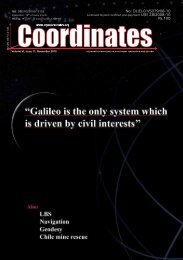Inside - Coordinates
Inside - Coordinates
Inside - Coordinates
Create successful ePaper yourself
Turn your PDF publications into a flip-book with our unique Google optimized e-Paper software.
GEODESY<br />
The Potential of VSOP2<br />
The feasibility of the latest SVLBI program—VSOP2 for geodetic applications is analyzed<br />
WEI Erhu<br />
Associate professor, Ph.<br />
D, School of Geodesy<br />
and Geomatics, Wuhan<br />
University, China.<br />
ehwei@sgg. whu. edu. cn<br />
LIU Jingnan<br />
President, Wuhan University,<br />
Academician of CAE, China<br />
jnliu@whu.edu.cn<br />
YAN Wei<br />
Master candidate, School<br />
of Geodesy and Geomatics,<br />
Wuhan University, China.<br />
2201feihong@163.com<br />
Fig 1 Simulate orbit of VSOP and VSOP2<br />
20 | <strong>Coordinates</strong> October 2007<br />
SVLBI (Space Very Long Baseline<br />
Interferometry) is an extension of the<br />
ground-based VLBI into the space. It has<br />
some important potential applications<br />
in geodesy and geodynamics, including<br />
the definition, practical realization, and<br />
the interconnection of different reference<br />
frames, determining the geocentric<br />
positions of VLBI stations, estimation<br />
of the gravity field of the Earth, and<br />
satellite orbit determination using the<br />
delay and delay rate observables.<br />
The idea of SVLBI was brought forward<br />
by N, S. Kardashev in 1970s. More<br />
deeper research had been done in 1970s<br />
and 1980s. With the launching of the<br />
first SVLBI satellite of the VLBI Space<br />
Observatory Programme (VSOP) of Japan,<br />
in February 1997, this technique has<br />
become a reality. An international team of<br />
scientists, working under the auspices of<br />
the FÖMI Satellite Geodesy Observatory,<br />
Hungary, has designed the Geodesy<br />
Demonstration Experiment (GEDEX), for<br />
the purpose of exploring the feasibility<br />
of the geodetic applications of SVLBI.<br />
However, several major problems also<br />
exist. It is not suitable for geodetic and<br />
geodynamic study, which requires precise<br />
tracking capabilities resulting in cm<br />
orbit accuracy. But the precision of orbit<br />
determination is within 10 meters. It is not<br />
suitable to frequently changing observing<br />
objects. So it<br />
cannot provide<br />
observations<br />
aiming at more<br />
radio sources,<br />
which are<br />
required for<br />
geodetic and<br />
geodynamical<br />
studies. On the<br />
other hand, the<br />
satellite stopped<br />
transmitting<br />
observation<br />
data after<br />
October 2003 and terminated its work<br />
on 02:28UT November 11th 2005.<br />
Introduction of VSOP2<br />
The project<br />
Following the success of the VSOP, a<br />
next generation space VLBI mission,<br />
currently called VSOP-2, is being planned<br />
in Japan with international collaboration<br />
for a launch as early as 2012.<br />
Although there are some obvious defects<br />
in VSOP, it is more preponderant than<br />
ground-based VLBI. For example, it can<br />
provide radio observation with a baseline<br />
length longer than the diameter of the<br />
Earth to increase observation resolution;<br />
also, it can provide all-day VLBI imaging;<br />
It has the ability of quick-imaging by<br />
the fast movement of VSOP surrounding<br />
the Earth; Observation of microscale<br />
characteristic is provided by the reduction<br />
of u – v empty and so on (SHEN Zhiqiang,<br />
1998). VSOP can achieve more difficult<br />
researches with these advantages,<br />
such as revealing the fine structures of<br />
active galactic nuclei (AGNs). VSOP<br />
has achieved its preconcerted mission<br />
requirement and has obtained some<br />
successes after several years, including:<br />
the quick-change of radio source in 1 day<br />
can be observed by quick-imaging; northsouth<br />
resolution is increased obviously;<br />
increasing the dynamic range of image<br />
(WAN Tongshan, 1999). So VSOP has<br />
promoted the development of SVLBI.<br />
Based on the successes of VSOP, the<br />
science goals for the VSOP-2 mission<br />
will place the emphasis on observations<br />
in the millimeter wave-band, enabling<br />
imaging on the scale of the accretion disk<br />
and jet acceleration region surrounding<br />
the supermassive black holes in the center<br />
of active galactic nuclei, and allow the<br />
structure of protostellar magnetospheres to
















